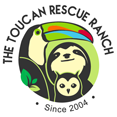Our Mission
The Toucan Rescue Ranch (TRR) mission is to rescue, rehabilitate, and release Costa Rica wildlife. TRR works with a model that focuses on conservation, education, and research to ensure a brighter tomorrow for Costa Rica wildlife.
Who is the Toucan Rescue Ranch
TRR emphases on the care, rehabilitation, and release of national wildlife. We receive and care for confiscated, sick, and injured animals from government agencies. The Toucan Rescue Ranch works closely with the Ministry of Environment and Energy of Costa Rica (MINAE) who brings injured and displaced wildlife to the center. TRR provides sanctuary while giving treatment, rehabilitation, and when possible, release to their natural environment. We specialize in toucans, sloths, and owls, however, we have a large array of wildlife from weasels, porcupines, cats, kinkajous, parrots, and so forth.
Some History
The Toucan Rescue Ranch (TRR) was founded in 2004 by Leslie Howle and Jorge Murillo. The original intention of TRR was to rescue, rehabilitate, and release Costa Rica toucans. MINAE (wildlife governing agency) noticed the success TRR had with toucans and began bringing various bird species. In 2007, when a baby sloth given the name Millie arrived, TRR transitioned into a full-time, multi-species wildlife rescue facility that specialize in toucans, sloths, and owls. TRR receives, cares for, and releases a wide range of species.
TRR Goals
- To establish a captive breeding program for all six species of Costa Rican toucans.
- To accept, evaluate and treat rescued animals in need.
- To rehabilitate and release injured wildlife back to its’ natural environment.
- Provide educational programs, research sites, and facilities across Costa Rica.
- Provide volunteer opportunities for national and international individuals.
Timeline & Milestones
TRR made history by becoming the first facility in Costa Rica and the second in the world to have parent raised captive bred emerald toucanets. TRR applied knowledge learned from the emerald toucanets to keel-billed toucans. In 2016 TRR became the first facility in Costa Rica to have parent raised captive bred keel-billed toucans.
TRR invested in a 25-acre piece of property in Nazareth, Sarapiqui, Costa Rica. On this property we started a cooperative reforestation project with a Costa Rican company called Café Britt. In 2017 and 2018 several species of native trees were re-planted on this property to help bridge fragmented rainforest canopy as well as provide new refuge and food for released and wild animals.
A small veterinary clinic was built at headquarters in San Isidro, Heredia, Costa Rica. Generous donations allowed TRR to equip the clinic with an anesthesia machine, bandaging supplies, ultrasound machine, medications, etc. The clinic has been in constant use since its completion. Today, we are nationally recognized for our successful medical work on rescued wildlife. To ensure the utmost care and recovery the Toucan Rescue Ranch works with orthopedic surgeons, pathologists, radiologist, and physical therapists who visit headquarters to perform these practices, as well as, working in collaboration with their premier facilities.
A farm owned by Leslie and Jorge in Sarapiqui was turned into a soft release site for rehabilitated mammals and birds. Volunteers with backgrounds in zoology, biology, wildlife, and veterinary medicine are given an opportunity to gain hands-on-experience monitoring and releasing rehabilitated wildlife.
TRR partnered with The Sloth Institute of Costa Rica to form the Saving Sloths Together (SST) project. By combining each organizations’ skills and knowledge it has improved the success of sloth rescue, rehabilitation, and release in Costa Rica.
The sloth release efforts have grown. TRR receives many orphaned sloths each year. Thanks to TRR’s continued partnership with Café Britt and The Sloth Institute, TRR can acquire tracking equipment for more sloth releases. This equipment enhances the Saving Sloths Together project and enables both institutions to monitor sloth release movements, activities, and intervene if sloths do not appear to be adjusting to life in the wild.

